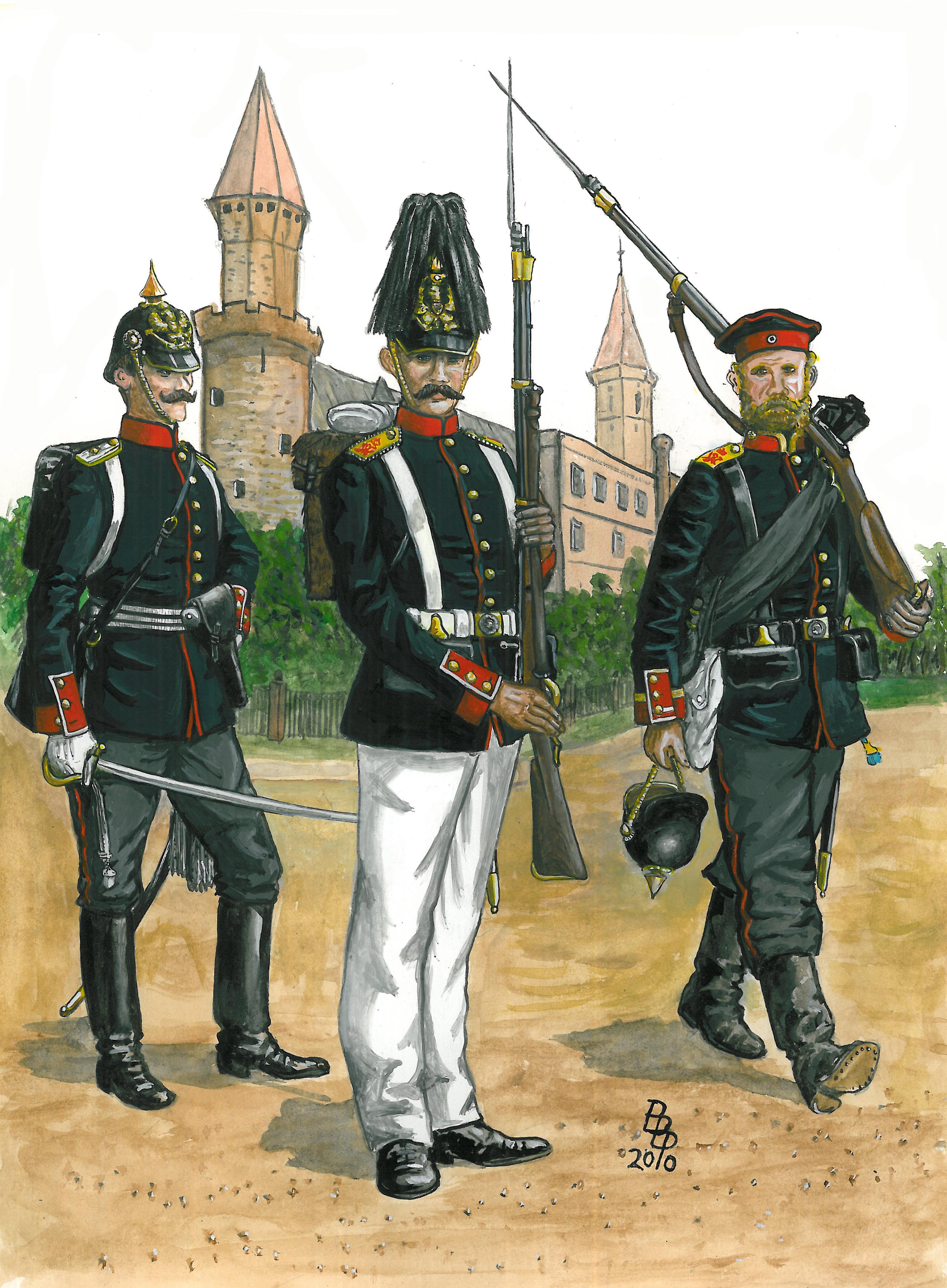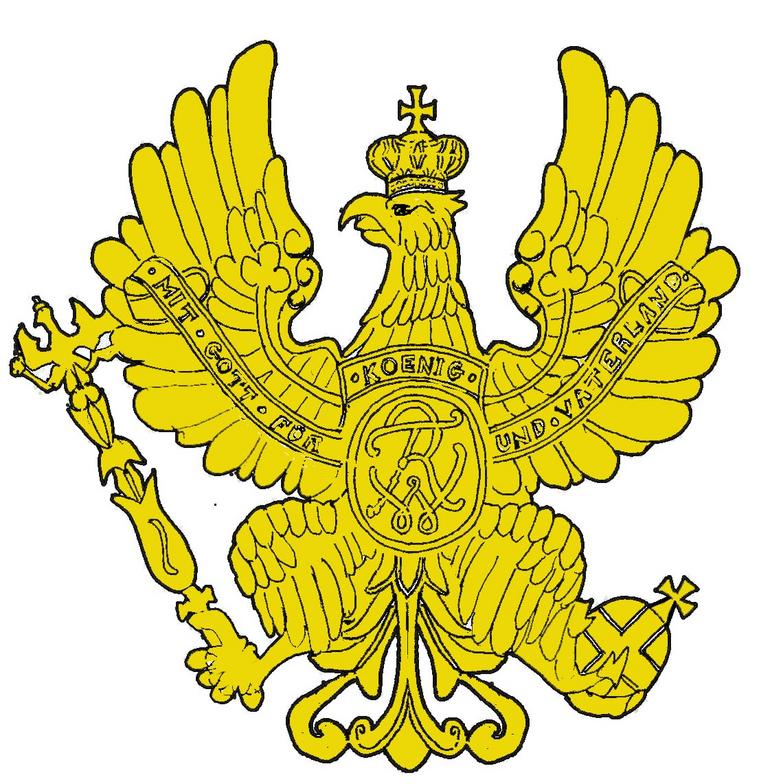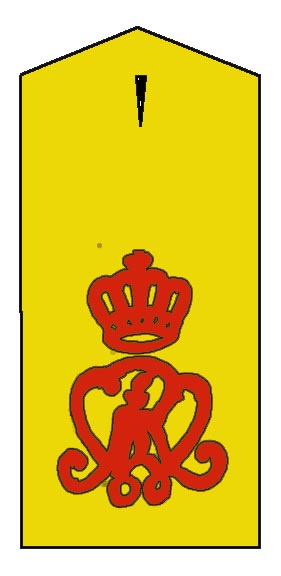PRUSSIA
Grenadier-Regiment König Wilhelm I
(2. Westpreußisches Nr 7)
Officer, Grenadier & Sergeant
1867-1871
Helmet Plate of Grenadier Regt. No. 7
The regiment was raised in 1797 as Infantry Regiment No. 58 ‘Von Courbiere’ as part of the East Prussian Inspectorate, garrisoned at Goldapp, Angerburg and Gumbinnen. It was not present at Jena in 1806, but was besieged in Danzig the following year and when the city surrendered on 24th May 1807, the regiment was broken up. On September 7th 1808 it was reformed as 2nd West Prussian Infantry Regt. (Von Courbiere) No. 7 from various disbanded battalions. In 1812 its 1st and Fusilier battalions were combined with the 1st West Prussian IR to serve under Yorke as part of the Prussian contribution to Napoleon’s invasion of Russia. They were designated ‘Combined Field Regiment No. 5. During the War of Liberation (1813-15) various elements of the regiment fought in all of the major (and many minor) actions including Gross-Görschen, Bautzen, Dresden and Hellendorf. The whole regiment was present at Leipzig on Oct 16-18 1813. In 1814 The Fusilier Battalion took part in the invasion of France at the actions of Étoges, Gué-á-Tremes and Lâon. In the 1815 Waterloo Campaign, the regiment fought at Ligny on June 16th.
 The long peace that followed the Napoleonic Wars saw the regiment in various garrisons including Liegnitz in Silesia where it would eventually find its permanent home. By 1840s the 7th Grenadiers were established in V Army Corps, 9th Division, 18th Brigade, a position it would enjoy for the rest of its existence. They saw no action in either the 1848 revolutions or the 1864 Schleswig War. As part of V Army Corps they saw much service in the Austro-Prussian War of 1866 fighting at Nachod, Skalitz and Königgrätz under the command of the doughty old General von Steinmetz. In the Franco-Prussian War they fought at Weissenberg, Wörth and Sedan as well as the siege of Paris. In their ranks was a young officer who had joined the regiment in April 1870. His name was 2nd Lieutenant Helmuth von Moltke, nephew and namesake of the famed Prussian Chief of the General Staff. He was commended for his bravery at Weissenberg and obtained a transfer to the 1st Foot Guards after the war. Better known as “Moltke the Younger”, he would assume his uncle’s post in 1913. Sadly, his leadership in implementing Schlieffen’s plan for the envelopment of Paris in 1914 failed and broke him.
The long peace that followed the Napoleonic Wars saw the regiment in various garrisons including Liegnitz in Silesia where it would eventually find its permanent home. By 1840s the 7th Grenadiers were established in V Army Corps, 9th Division, 18th Brigade, a position it would enjoy for the rest of its existence. They saw no action in either the 1848 revolutions or the 1864 Schleswig War. As part of V Army Corps they saw much service in the Austro-Prussian War of 1866 fighting at Nachod, Skalitz and Königgrätz under the command of the doughty old General von Steinmetz. In the Franco-Prussian War they fought at Weissenberg, Wörth and Sedan as well as the siege of Paris. In their ranks was a young officer who had joined the regiment in April 1870. His name was 2nd Lieutenant Helmuth von Moltke, nephew and namesake of the famed Prussian Chief of the General Staff. He was commended for his bravery at Weissenberg and obtained a transfer to the 1st Foot Guards after the war. Better known as “Moltke the Younger”, he would assume his uncle’s post in 1913. Sadly, his leadership in implementing Schlieffen’s plan for the envelopment of Paris in 1914 failed and broke him.
 His old regiment in V Army Corps spent the entire First World War on the Western Front, mostly in the Alsace-Lorraine and Vosges theatres. They shared the slaughter of the bloody battle for Verdun and traded trench warfare with the French. They did not take part in the 1918 offensive but fought some final actions with the freshly arrived American Army a few weeks before the armistice. What remained of them in December 1918 dutifully marched back to Liegnitz where they were disbanded on the 22nd of that month. A proud regiment had passed into history.
His old regiment in V Army Corps spent the entire First World War on the Western Front, mostly in the Alsace-Lorraine and Vosges theatres. They shared the slaughter of the bloody battle for Verdun and traded trench warfare with the French. They did not take part in the 1918 offensive but fought some final actions with the freshly arrived American Army a few weeks before the armistice. What remained of them in December 1918 dutifully marched back to Liegnitz where they were disbanded on the 22nd of that month. A proud regiment had passed into history.
UNIFORM
 Our illustration shows members of the regiment in various orders of dress worn from 1867 to 1871. The uniform was virtually the same as that worn in the previous decade with the following changes. The helmet (Pickehaube) was lowered somewhat in 1867 and lost its bar down the back. The quatrefoil holding the spike was also replaced by a disc. The tunic remained the same except that the collar was now entirely in facing cloth rather than the patches previously worn. A new pack was issued for the men with larger pockets on the side.
Our illustration shows members of the regiment in various orders of dress worn from 1867 to 1871. The uniform was virtually the same as that worn in the previous decade with the following changes. The helmet (Pickehaube) was lowered somewhat in 1867 and lost its bar down the back. The quatrefoil holding the spike was also replaced by a disc. The tunic remained the same except that the collar was now entirely in facing cloth rather than the patches previously worn. A new pack was issued for the men with larger pockets on the side.
 As part of the Vth Army Corps, their shoulder straps were yellow and their cuff patches were piped white. For parades the twelve grenadier regiments had the privilege of wearing a black horsehair plume on their helmets. The 7th Grenadiers had the special distinction of bearing the crowned monogram of King William I on their shoulder straps in red. (See Below)
As part of the Vth Army Corps, their shoulder straps were yellow and their cuff patches were piped white. For parades the twelve grenadier regiments had the privilege of wearing a black horsehair plume on their helmets. The 7th Grenadiers had the special distinction of bearing the crowned monogram of King William I on their shoulder straps in red. (See Below)
The central figure shows a Grenadier of the 1st battalion in summer parade dress c. 1867/8. He is still wearing the old pattern helmet as they had yet to receive the new ones. Even when they came, the old one was worn for some time on parade as they appeared more imposing. His tunic is of the new pattern, as is his valise with the large pockets. The black and white piping around his yellow shoulder straps reveal him as a One Year Volunteer. He is presenting arms with the 1843 model Zundnadnelgewehr (Needle rifle).
 The officer on the left is dressed for service in the war of 1870. He is from the 1st or 2nd battalion as the straps on his officer’s valise are white leather. He is distinguished by his silver shoulder boards (for wear in the field) on a yellow backing and by his national sash worn around his waist. He carries a pistol in a black holster on his left and carries a privately purchased map case over his left shoulder.
The officer on the left is dressed for service in the war of 1870. He is from the 1st or 2nd battalion as the straps on his officer’s valise are white leather. He is distinguished by his silver shoulder boards (for wear in the field) on a yellow backing and by his national sash worn around his waist. He carries a pistol in a black holster on his left and carries a privately purchased map case over his left shoulder.
 On the right, the sergeant is from the 3rd Fusilier battalion denoted by his black leather equipment. He is dressed as he would have appeared just before the entry into Paris. He wears his undress cap (mutze) and carries his 1867 pattern helmet in his hand. Often on the march it was carried with its chinstrap slung over the sidearm hilt. His rank is indicated by the gold braid around the top of his collar and cuffs and the brass disc bearing the heraldic eagle on the side of his collar. He carries a later model needle rifle with clearly shown cheekpiece on the butt. His ‘hirsute’ appearance was typical for the campaign and soldiers were generally allowed to grow whiskers provided they didn’t shave at all, although this rule was often ignored.
On the right, the sergeant is from the 3rd Fusilier battalion denoted by his black leather equipment. He is dressed as he would have appeared just before the entry into Paris. He wears his undress cap (mutze) and carries his 1867 pattern helmet in his hand. Often on the march it was carried with its chinstrap slung over the sidearm hilt. His rank is indicated by the gold braid around the top of his collar and cuffs and the brass disc bearing the heraldic eagle on the side of his collar. He carries a later model needle rifle with clearly shown cheekpiece on the butt. His ‘hirsute’ appearance was typical for the campaign and soldiers were generally allowed to grow whiskers provided they didn’t shave at all, although this rule was often ignored.
 The background of the illustration shows the Ducal castle in the regiment’s long time garrison of Liegnitz, a city in Lower Silesia on the Katzbach River about forty miles NW of Breslau. It is now known as Legnica in Polish Silesia on the Kaczawa river.
The background of the illustration shows the Ducal castle in the regiment’s long time garrison of Liegnitz, a city in Lower Silesia on the Katzbach River about forty miles NW of Breslau. It is now known as Legnica in Polish Silesia on the Kaczawa river.







